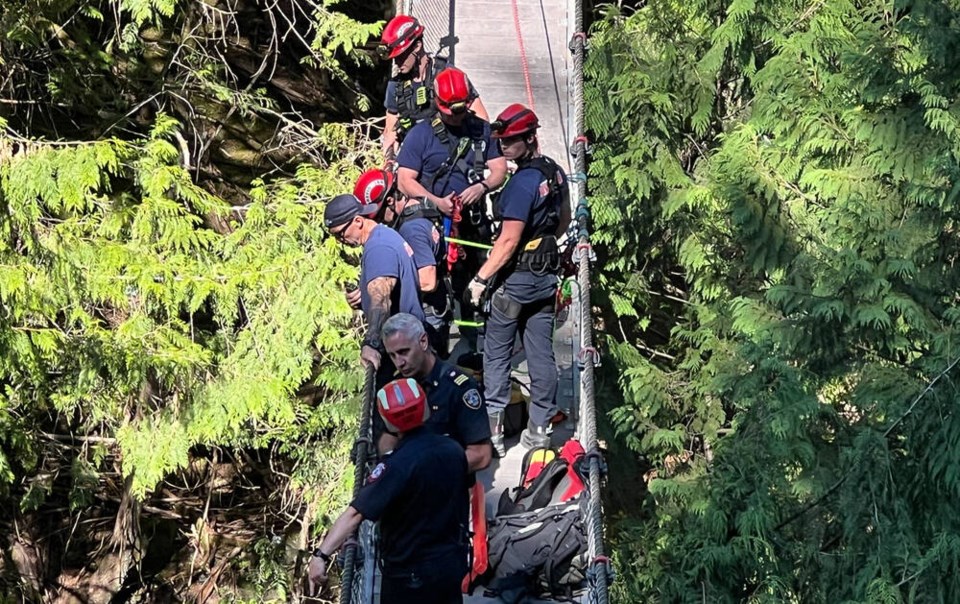After a slow start to the season, District of North Vancouver Fire and Rescue Services are carrying injured and dying cliff jumpers out of Lynn Canyon on a now-weekly basis.
The crew’s rope rescue team was back to Lynn Creek on Saturday after a 21-year-old man dislocated his shoulder jumping into 90-foot pool.
“It’s an extremely dangerous activity and so that leaves the door open for a lot of different injuries,” said assistant fire chief Scott Ferguson.
The quickest and safest way down to the creek’s edge is at the bottom of a rope system anchored at the suspension bridge, Ferguson said. They lowered two members down who got the man to a safe spot on the shore where he could be harnessed up and then slowly pulled 50 metres back up to paramedics who were waiting at the top of the canyon.
The District of North Vancouver has been stepping up communications efforts to warn visitors about the risks of cliff jumping in the canyon, but crowds are still showing up and inevitably, someone gets hurt or worse.
On July 3, 21-year-old Harman Singh Sandhu jumped in at Twin Falls July 3 but hit a rock and drowned. Friends of the man launched an online fundraiser to help cover the cost of returning his body to his family in India.
Just days later, crews were back in the canyon to rescue an intoxicated man who hurt himself jumping into the canyon.
“We’ve been to the canyon in the last couple of weeks, I’d say at least a half-dozen times, whether it’s Twin Falls or the suspension bridge area. And a lot of them are high-risk activities that are causing these issues,” Ferguson said.
Ferguson stressed that visitors should only be entering the creek in spots that are open to the public and with slow-moving water.
“Lynn Canyon is a beautiful and inviting place, especially in this hot weather, but it has its dangers as well. The water is extremely cold. There’s hidden dangers under the water like rocks, trees, logs. And the river is constantly changing because of the force of the water,” he said, adding that District of North Vancouver park rangers are happy to help direct people to safe places to cool off.
Each of the three North Shore fire departments has a dedicated rescue truck and there are agreements in place for the crews to cover for each other when one of them is tasked. At the time of the Lynn Canyon call, a hiker broke their ankle on the BCMC Trail on Grouse Mountain.
“Our resources were drained quite significantly across the North Shore at this time, because we had two rescues going,” Ferguson said. “We just want people to keep that in mind also, when they’re participating in high-risk activities on the North Shore.”
North Shore Rescue, meanwhile, was having an even busier day. The team’s volunteers were out as early as 5 a.m. to provide rescue coverage for the annual Knee Knacker. Before the day was out, they were called out four times including two medical rescues for hikers requiring a helicopter hoist to get to safety. One was for a man who broke his leg while jumping from rock to rock while wearing a heavy backpack on Mount Seymour. The team was also called for a mountain biker in a diabetic emergency north of Pemberton and, on their return flight home, rescue volunteers used night vision goggles to spot two lost hikers near Lions Bay.
“There’s definitely a lot of moving pieces and triage came into play for this one,” said Scott Merriman, North Shore Rescue team leader.
The team is on pace to have another extremely busy year, he added.
“It’s certainly picked up since the weather has improved,” he said.
So many of North Shore Rescue’s calls could be avoided, Merriman said, if people would wear proper hiking boots for the terrain they are headed into.
“The ankle injury is one that we see a lot,” he said. “There’s more roots, there’s more rocks, there’s more opportunity to roll an ankle. Having the proper footwear can make the difference between having to call us and not.”




